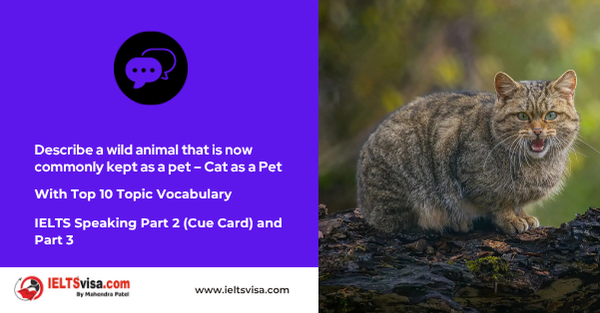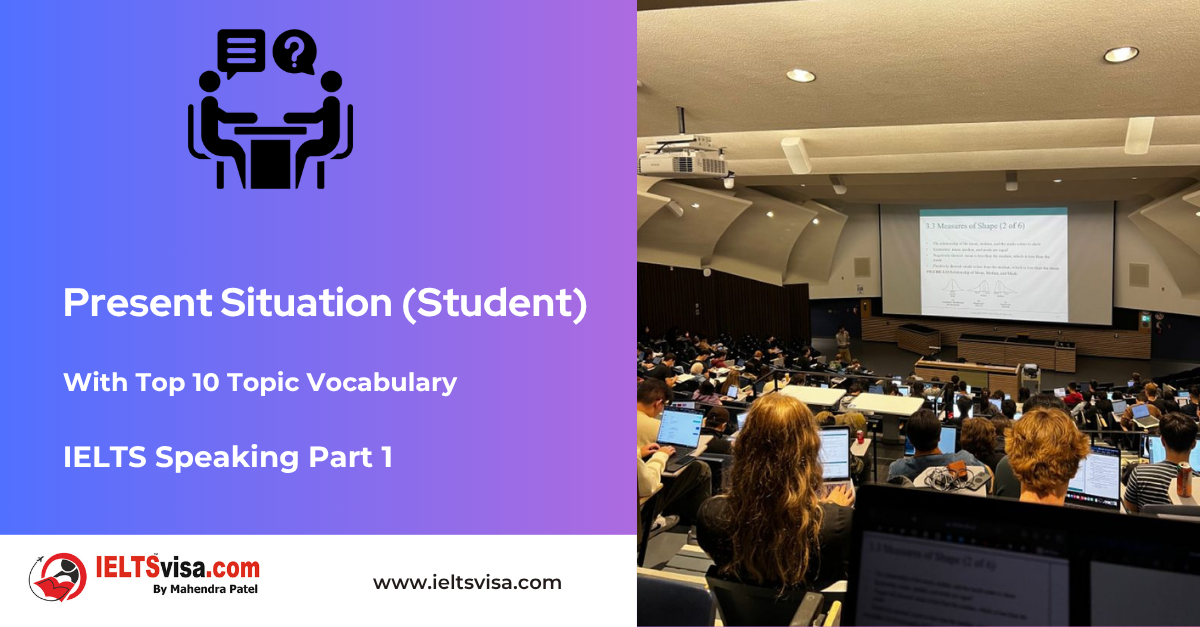Describe a wild animal that is now kept as a pet - Cat
IELTS Speaking Part 2 (Cue Card) Part 3: Follow-Up Questions
Describe a wild animal that is now kept as a pet – Cat
🗂️ Part 2 – Cue Card
Describe a wild animal that is now kept as a pet.
You should say:
- What the animal is
- Where and how it lives now
- How it behaves
And explain why you think it’s interesting or important.
🗣️ Sample Answer
One wild animal that is now commonly kept as a pet is the domestic cat. Cats were originally wild animals, hunting small creatures in forests and deserts, but over thousands of years, they became companions to humans. Today, cats are found in homes all over the world, including mine. I have a cat named Leo, and he embodies a unique blend of curiosity, independence, and affection.
I adopted him from a local animal shelter. At first, he was shy and would often hide under furniture. Over time, he adapted to indoor life and became very friendly. He loves to sit on the windowsill and watch the birds outside, which I believe is a reminder of his wild instincts. He also plays with toy mice and chases anything that moves, which shows his natural hunting behaviour.
What I find interesting is how such a once-wild creature can now live so comfortably indoors, using a litter box and responding to human interaction. It shows how adaptable animals can be when treated with care. Cats still retain many of their wild traits, like independence and night-time activity, but they’ve learned to coexist with people peacefully and lovingly. Owning a cat has taught me a great deal about responsibility and the importance of patience in establishing trust with animals.
🔁 Part 3: Follow-Up Questions
1. Do you think all wild animals can be domesticated and made into pets?
No, not all wild animals are suitable for domestic life. Some are too dangerous or require special environments. Only a few species, such as cats and dogs, have adapted well to living alongside humans over the centuries.
2. What are the advantages of keeping a pet like a cat?
Cats are low-maintenance, clean, and can be affectionate companions. They help reduce stress and provide emotional support. Their playful behaviour also brings joy and entertainment.
3. Are there any risks associated with keeping once-wild animals?
Yes, they may show unpredictable behaviour if they feel threatened or stressed. Some may try to escape or revert to their instincts. It’s essential to provide them with proper care and understand their unique nature.
4. How have cats adapted to living with humans?
Cats have learned to rely on humans for food and shelter. They communicate with us through sounds and nonverbal cues, such as body language. While they are still independent, they enjoy human interaction and form bonds with their owners.
5. Why do people choose cats over other pets?
Many people live in apartments where cats are easier to manage than dogs. Cats don’t need to be walked and can be left alone for longer periods. Their quiet and calm nature also appeals to many.
6. Should exotic animals be kept as pets?
In general, it’s not advisable. Exotic animals may need specific care that regular homes can’t provide. They may also pose health or safety risks and should ideally live in natural habitats or sanctuaries.
7. How can someone properly care for a pet cat?
Regular feeding, clean water, a litter box, and occasional vet visits are essential. Cats also need stimulation through toys and attention. Most importantly, they need a safe and loving environment.
8. Are there any laws about keeping wild animals as pets?
Yes, many countries have strict laws. For example, keeping large wild cats, such as tigers, is illegal in many places. These laws help protect both the animals and the people.
9. What’s the emotional impact of having a pet?
Pets can help reduce loneliness and anxiety. They offer unconditional love and companionship. Caring for a pet also gives people a sense of purpose and routine.
10. What qualities do cats and wild animals still share?
Cats still possess strong instincts, such as hunting, territorial behaviour, and nighttime activity. They’re also very alert and cautious, traits they inherited from their wild ancestors.
Top 10 Topic Vocabulary – Describe a wild animal that is now kept as a pet – Cat
|
Vocabulary |
Type |
Meaning |
Synonyms |
Antonyms |
Word Family |
Example Sentence |
|
Domesticated |
Adj |
Tamed and adapted to live with humans |
Tamed, trained |
Wild |
Domesticate, domestication |
Cats are domesticated wild animals now kept as pets. |
|
Instinct |
Noun |
A natural, automatic behavior |
Reflex, impulse |
Learned behavior |
Instinctive |
My cat still shows his hunting instinct when chasing toys. |
|
Adaptable |
Adj |
Able to adjust to new environments |
Flexible, versatile |
Inflexible |
Adapt, adaptation |
Cats are very adaptable animals. |
|
Shelter |
Noun |
A place that provides safety or protection |
Refuge, haven |
Exposure |
Sheltered |
I adopted my cat from an animal shelter. |
|
Litter box |
Noun |
A container with litter used for a cat’s toilet |
— |
— |
— |
He quickly learned to use the litter box. |
|
Affectionate |
Adj |
Showing love and care |
Loving, warm |
Cold, distant |
Affection |
My cat is very affectionate and sits on my lap. |
|
Predatory |
Adj |
Relating to hunting or killing other animals for food |
Hunting, carnivorous |
Herbivorous |
Predator, prey |
Even pet cats show some predatory behavior. |
|
Independent |
Adj |
Not needing help from others |
Self-reliant |
Dependent |
Independence |
Cats are known for being independent pets. |
|
Tame |
Adj |
Not wild or dangerous; trained to behave |
Docile, gentle |
Wild, savage |
Tamed, taming |
Although tame, cats still have wild instincts. |
|
Companionship |
Noun |
A feeling of friendship and closeness |
Friendship, closeness |
Loneliness |
Companion |
Many people keep pets for companionship. |

Our Books
Master IELTS Speaking Part 1
IELTS Writing Task 1 Book
IELTS Writing Task 2 Book
Practice IELTS Other Modules
IELTS Listening
The IELTS Listening test assesses how well you can understand spoken English in various contexts. It lasts about 30 minutes and is divided into four sections with a total of 40 questions. The listening tasks become increasingly difficult as the test progresses.
IELTS Academic Reading
The IELTS Academic Reading section assesses your ability to understand and interpret a variety of texts in academic settings. It is designed to evaluate a range of reading skills, including skimming for gist, reading for main ideas, reading for detail, understanding inferences, and recognizing a writer's opinions and arguments.
IELTS Speaking
The IELTS Speaking test assesses your ability to communicate in English on everyday topics. It lasts 11-14 minutes and consists of three parts: introduction, cue card, and a discussion based on the cue card topic.
IELTS General Reading
IELTS General Reading tests your ability to understand and interpret various types of texts. Here are some key areas and types of content you can expect to encounter in the reading section, along with tips for effective preparation.
IELTS Academic Writing Task 1
In IELTS Academic Writing Task 1, you are presented with a visual representation of information, such as graphs, charts, tables, or diagrams, and you are required to summarize, compare, or explain the data in your own words.
IELTS General Writing Task 1
In IELTS General Writing Task 1, you are required to write a letter based on a given situation. The letter can be formal, semi-formal, or informal, depending on the prompt. Here’s a breakdown of the key components to include in your letter
IELTS Academic Writing Task 2
In IELTS Academic Writing Task 2, you are required to write an essay in response to a question or topic. Here’s a guide to help you understand the essential elements of this task
IELTS Exam Tips
To succeed in the IELTS exam, practice regularly, familiarize yourself with the test format, improve your vocabulary, develop time management skills, and take mock tests to build confidence.
Grammer for IELTS
Grammar is the foundation of effective communication in English. Understanding tense usage, subject-verb agreement, and sentence structure enhances clarity and coherence in writing and speaking.
Vocabulary for IELTS
Vocabulary plays a crucial role in the IELTS (International English Language Testing System) exam, especially in the Speaking and Writing sections. Here’s an overview of why vocabulary is important and how it impacts your performance
RECENT IELTS SAMPLES QUESTIONS AND ANSWERS
IELTS Speaking Part 1 – Favourite Sujbect – Physics
IELTS Speaking Part 1 - Favourite Sujbect - Physics Q: What is your favourite subject? A: My favourite subject...
IELTS Speaking Part 1 – Present Situation (Student)
IELTS Speaking Part 1 - Present Situation (Student) Q1: Are you a student or do you work?A: I’m a full-time...
IELTS Speaking Part 1 – Present Situation – Employee – as an International Student and Social Worker
IELTS Speaking Part 1 - Present Situation - Employee - as an International Student and Social Worker Q1: Are...
IELTS Speaking Part 1 – Persent Situation – Employee- as an Electric Engineer
IELTS Speaking Part 1 - Persent Situation - Employee- as an Electric Engineer Q1: What do you do for a...
IELTS Speaking Part 1 – Persent Situation – Employee – as an Software Engineer
IELTS Speaking Part 1 - Persent Situation - Employee - as an Software Engineer Q1: What do you do for a...
IELTS Speaking Part 1 – Persent Situation – Married
IELTS Speaking Part 1 - Persent Situation - Married Q1: Are you married?A: Yes, I am married. My spouse and I...













